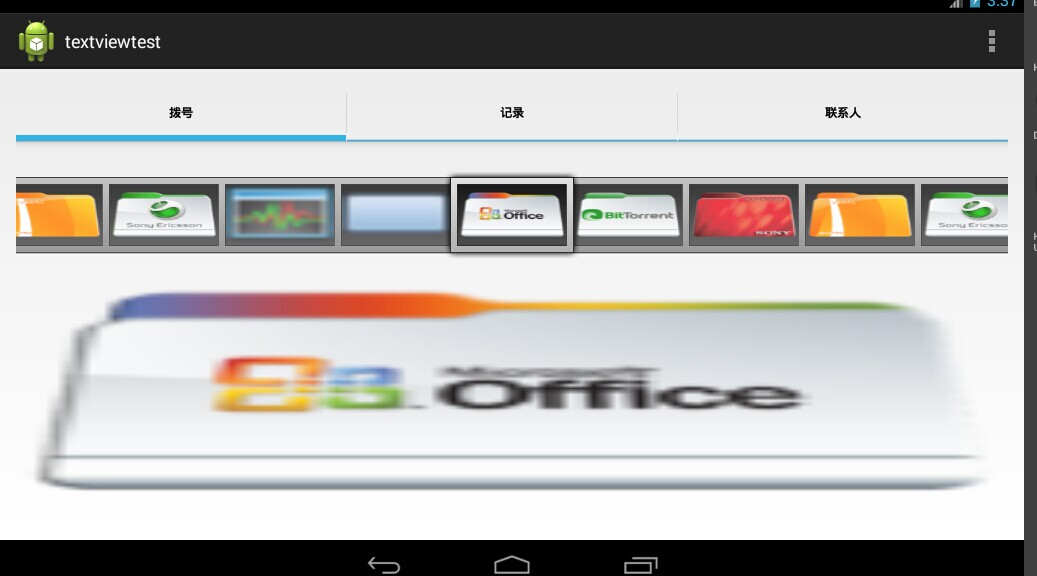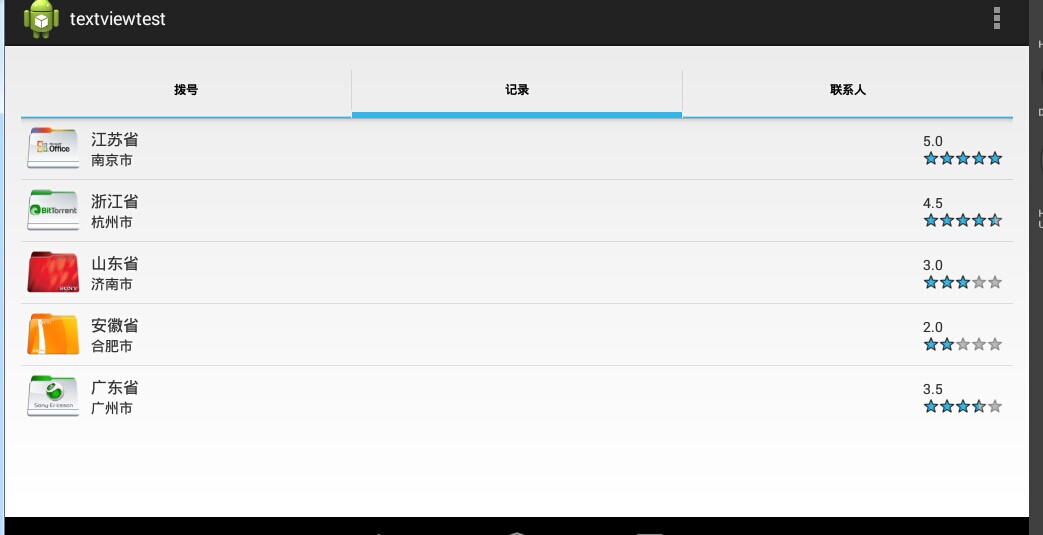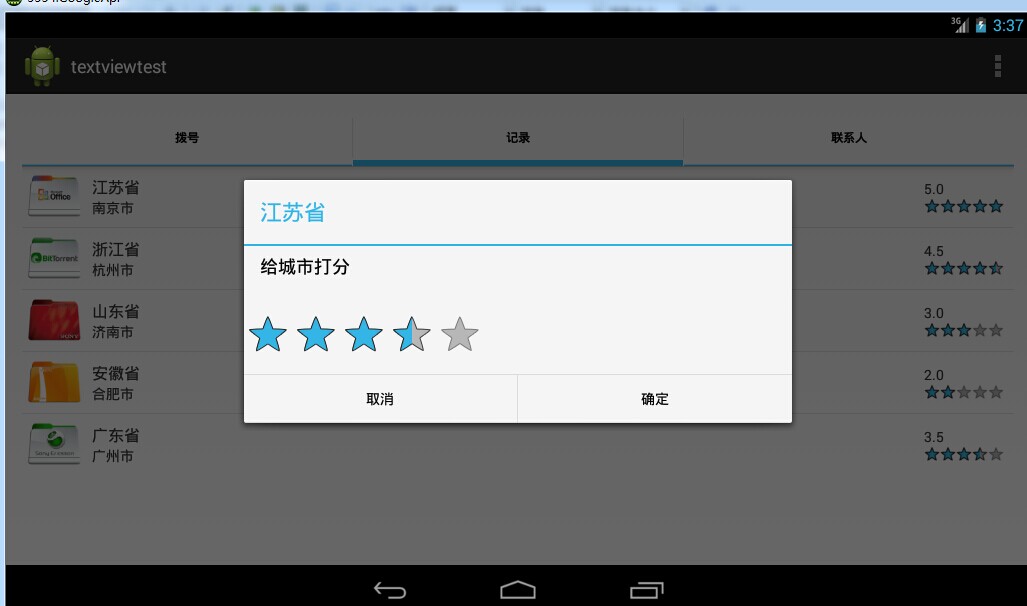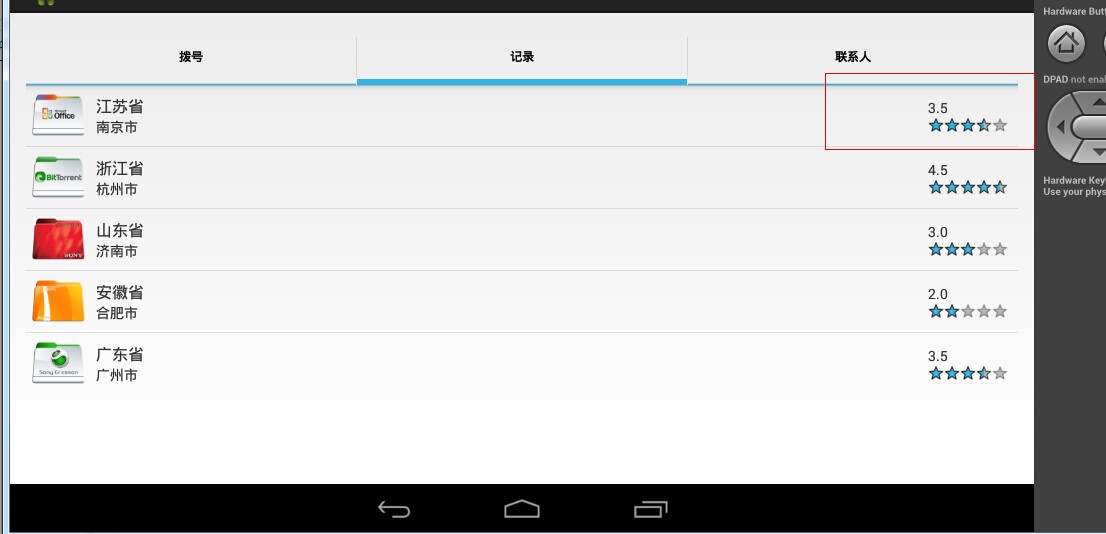Android学习Tabhost、gallery、listview、imageswitcher
Tabhost控件又称分页控件,在很多的开发语言中都存在。它可以拥有多个标签页,每个标签页可以拥有不同的内容。android中,一个标签页可以放 一个view或者一个activity。TabHost是标签控件类的核心类,也是标签的集合。
1.tabhost定义
android控件中有封装好的tab控件,直接拖一个到xml文件中。下面的代码都是tab控件自己生成的。
<RelativeLayout xmlns:android="http://schemas.android.com/apk/res/android"
xmlns:tools="http://schemas.android.com/tools"
android:layout_width="fill_parent"
android:layout_height="fill_parent"
android:paddingBottom="@dimen/activity_vertical_margin"
android:paddingLeft="@dimen/activity_horizontal_margin"
android:paddingRight="@dimen/activity_horizontal_margin"
android:paddingTop="@dimen/activity_vertical_margin"
tools:context=".MainActivity" > <TabHost
android:id="@android:id/tabhost"
android:layout_width="fill_parent"
android:layout_height="fill_parent"
android:layout_alignParentLeft="true"
android:layout_alignParentTop="true" > <LinearLayout
android:layout_width="match_parent"
android:layout_height="match_parent"
android:orientation="vertical" > <TabWidget
android:id="@android:id/tabs"
android:layout_width="match_parent"
android:layout_height="wrap_content" >
</TabWidget> <FrameLayout
android:id="@android:id/tabcontent"
android:layout_width="match_parent"
android:layout_height="match_parent" > <LinearLayout
android:id="@+id/tab1"
android:layout_width="match_parent"
android:layout_height="match_parent"
android:orientation="vertical" > </LinearLayout> <LinearLayout
android:id="@+id/tab2"
android:layout_width="match_parent"
android:layout_height="match_parent"
android:orientation="vertical" > </LinearLayout> <LinearLayout
android:id="@+id/tab3"
android:layout_width="match_parent"
android:layout_height="match_parent"
android:orientation="vertical" > </LinearLayout>
</FrameLayout>
</LinearLayout>
</TabHost> </RelativeLayout>
main.xml
在后台,可以通过tabhost.addtab方法添加分页。本例添加了3个标签,并且为其中的两个绑定了不同的activity。
TabHost tabhost=this.getTabHost();
LayoutInflater.from(this).inflate(R.layout.activity_main,tabhost.getTabContentView(),true);
tabhost.addTab(tabhost.newTabSpec("tab1").setIndicator("拨号").setContent(new Intent(this,MyGallery.class)));
tabhost.addTab(tabhost.newTabSpec("tab2").setIndicator("记录").setContent(new Intent(this,RatingListActivity.class)));
tabhost.addTab(tabhost.newTabSpec("tab3").setIndicator("联系人").setContent(R.id.tab3));
添加标签控件
2.MyGalleryxml
Gallery是相册控件,它可以水平或者垂直浏览多张图片。imgageswitcher控件可以用来以动画的方式切换图片。本例将imageswitcher和gallery控件相结合。gallery存放多张图片,而imageswitcher来显示图片。
首先来看xml文档的定义。
xml文档定义的很简单,只是包含一个布局控件、一个gallery和imageswitcher。
Gallery gallery;
ImageSwitcher imgwch;
//设置图片资源的id
private int[] imgIds={R.drawable.imgs1,R.drawable.imgs2,R.drawable.imgs3,R.drawable.imgs4,R.drawable.imgs5,R.drawable.imgs6,R.drawable.imgs7};
public void onCreate(Bundle savebundle)
{
super.onCreate(savebundle);
setContentView(R.layout.imgswitch);
imgwch=(ImageSwitcher)findViewById(R.id.imgswitcher1);
imgwch.setFactory(this);
//设置imageswitcher的图片动画显示
imgwch.setInAnimation(AnimationUtils.loadAnimation(this, android.R.anim.fade_in));
imgwch.setOutAnimation(AnimationUtils.loadAnimation(this, android.R.anim.fade_out));
gallery=(Gallery)findViewById(R.id.gallery);
//定义相册资源的适配器
ImageAdapter adapter=new ImageAdapter(this);
gallery.setAdapter(adapter);
gallery.setOnItemClickListener(new OnItemClickListener() { @Override
public void onItemClick(AdapterView<?> arg0, View arg1, int arg2,
long arg3) {
// TODO Auto-generated method stub
//设置imageswitcher的资源id,这里的数组下标示经过处理的,目的是为了能够循环显示图像
imgwch.setBackgroundResource(imgIds[arg2%imgIds.length]);
}
});
}
//定义imageswitcher的显示对象
public View makeView() {
ImageView imageView = new ImageView(this);
imageView.setBackgroundColor(Color.TRANSPARENT);
imageView.setScaleType(ImageView.ScaleType.FIT_CENTER);
imageView.setLayoutParams(new ImageSwitcher.LayoutParams(LayoutParams.FILL_PARENT,LayoutParams.FILL_PARENT));
return imageView;
}
public class ImageAdapter extends BaseAdapter
{
int mgallerybackground;
private Context context;
public ImageAdapter(Context context)
{
this.context=context;
//设置相册图像的显示风格
TypedArray typed=obtainStyledAttributes(R.styleable.Gallery);
mgallerybackground=typed.getResourceId(R.styleable.Gallery_android_galleryItemBackground, 0);
typed.recycle();
}
@Override
public int getCount() {
// TODO Auto-generated method stub
//可以循环浏览图像
return Integer.MAX_VALUE;
} @Override
public Object getItem(int position) {
// TODO Auto-generated method stub
return null;
} @Override
public long getItemId(int position) {
// TODO Auto-generated method stub
return 0;
} @Override
public View getView(int position, View convertView, ViewGroup parent) {
// TODO Auto-generated method stub
//设置图像的显示风格和显示资源
ImageView img1=new ImageView(context); img1.setScaleType(ImageView.ScaleType.FIT_XY);
img1.setLayoutParams(new Gallery.LayoutParams(136,88));
img1.setImageResource(imgIds[position%imgIds.length]);
img1.setBackgroundResource(mgallerybackground);
return img1;
}
ImageSwitcher
这里为相册指定了资源,并设置了显示的风格。也为imageswitcher设置了显示的对象,以及动画的淡入和淡出。
通过以上的代码,我们可以单击“拨号”,即可显示gallery页,同时,imageswitcher可以随着gallery浏览对象的变化而变化。
3.RatingList
本例是实现基于RatingBar和Listview的打分应用。
<?xml version="1.0" encoding="utf-8"?>
<LinearLayout xmlns:android="http://schemas.android.com/apk/res/android"
android:layout_width="fill_parent"
android:layout_height="fill_parent"
android:orientation="vertical" > <ListView
android:id="@+id/lvrating"
android:layout_width="fill_parent"
android:layout_height="wrap_content" > </ListView>
</LinearLayout>
listlv
这个xml文档用来定义显示的列表,有listview构成。下面需要定义listview的item项。
<?xml version="1.0" encoding="utf-8"?>
<LinearLayout xmlns:android="http://schemas.android.com/apk/res/android"
android:layout_width="fill_parent"
android:layout_height="wrap_content"
android:gravity="center_vertical"
android:orientation="horizontal" > <ImageView
android:id="@+id/ivLogo"
android:layout_width="60dp"
android:layout_height="60dp"
android:paddingLeft="5dp"
android:src="@drawable/ic_launcher" /> <RelativeLayout
android:layout_width="wrap_content"
android:layout_height="wrap_content"
android:layout_gravity="right"
android:orientation="vertical"
android:padding="10dp" > <TextView
android:id="@+id/tvApplicationName"
android:layout_width="wrap_content"
android:layout_height="wrap_content"
android:textSize="16dp" /> <TextView
android:id="@+id/tvAuthor"
android:layout_width="wrap_content"
android:layout_height="wrap_content"
android:layout_below="@id/tvApplicationName"
android:textSize="14dp" /> </RelativeLayout> <RelativeLayout
android:layout_width="fill_parent"
android:layout_height="wrap_content"
android:gravity="right"
android:padding="10dp"
android:orientation="vertical" > <TextView
android:id="@+id/tvRating"
android:layout_width="wrap_content"
android:layout_height="wrap_content"
android:text="5.0" /> <RatingBar
android:id="@+id/ratingbar"
style="?android:attr/ratingBarStyleSmall"
android:layout_width="wrap_content"
android:layout_height="wrap_content"
android:layout_below="@id/tvRating"
android:numStars="5" /> </RelativeLayout>
</LinearLayout>
list_item
对于listview的使用方法,大家都应该很清楚的。一般定义复杂的列表显示,都需要通过listview以及item组成。在后台可以通过simpleadapter或者baseadapter来绑定数据。
public void onCreate(Bundle savedbundle)
{
super.onCreate(savedbundle);
setContentView(R.layout.listv);
ListView listview=(ListView)findViewById(R.id.lvrating);
final MyBaseadapter adapter=new MyBaseadapter(this); listview.setAdapter(adapter);
listview.setOnItemClickListener(new OnItemClickListener() { @Override
public void onItemClick(AdapterView<?> arg0, View arg1, final int arg2,
long arg3) {
// TODO Auto-generated method stub
View myView=getLayoutInflater().inflate(R.layout.rating, null);
final RatingBar ratingbar=(RatingBar)myView.findViewById(R.id.ratingBar1);
ratingbar.setRating(applicationrating[arg2]);
new AlertDialog.Builder(RatingListActivity.this).setTitle(applicationNames[arg2]).setMessage("给城市打分").setView(myView)
.setPositiveButton("确定", new OnClickListener() { @Override
public void onClick(DialogInterface dialog, int which) {
// TODO Auto-generated method stub
adapter.setRating(arg2, ratingbar.getRating());
}
}).setNegativeButton("取消", null).show();
}
});
}
oncreate
在oncreate方法中为listview绑定数据,并设置listview的监听事件。MyBaseadapter类继承BaseAdapter类。
public class MyBaseadapter extends BaseAdapter
{ private Context context;
public MyBaseadapter(Context context)
{
this.context=context;
}
@Override
public int getCount() {
// TODO Auto-generated method stub
return resIds.length;
} @Override
public Object getItem(int position) {
// TODO Auto-generated method stub
return null;
} @Override
public long getItemId(int position) {
// TODO Auto-generated method stub
return 0;
} @Override
public View getView(int position, View convertView, ViewGroup parent) {
// TODO Auto-generated method stub
TextView tvapplicationname;
if(convertView==null)
{
//对于这里的使用,真的有太多的方法,这里是为了要或者我们定义的那个item.xml。
convertView=LayoutInflater.from(context).inflate(R.layout.ratinglist, null);
}
tvapplicationname=(TextView)convertView.findViewById(R.id.tvApplicationName);
tvapplicationname.setText(applicationNames[position]);
ImageView ivlogo=(ImageView)convertView.findViewById(R.id.ivLogo);
ivlogo.setImageResource(resIds[position]);
TextView tvauthor=(TextView)convertView.findViewById(R.id.tvAuthor);
tvauthor.setText(authors[position]);
TextView tvrating=(TextView)convertView.findViewById(R.id.tvRating);
tvrating.setText(String.valueOf(applicationrating[position]));
RatingBar ratingbar=(RatingBar)convertView.findViewById(R.id.ratingbar);
ratingbar.setRating(applicationrating[position]);
return convertView;
}
public void setRating(int position,float rating)
{
applicationrating[position]=rating;
notifyDataSetChanged();
} }
MyBaseAdapter
BaseAdapter中getView方法使用容易出错,经常会出现获取不到xml文档的情况,主要是Layoutinflater.inflate的使用。这里在获取view对象后,然后为view中的每个控件赋值。最后将这个view返回。这里返回的是listview的每一个item。
上面的单击事件中,选择某一项后,可以对该项进行评分。
程序运行的界面,如下:




本例顺利实现了一系列的功能。下例将会带来arcgis中gp模型的建立以及发布。
Android学习Tabhost、gallery、listview、imageswitcher的更多相关文章
- Android学习笔记 Gallery图库组件的使用
activity_main.xml <LinearLayout xmlns:android="http://schemas.android.com/apk/res/android&qu ...
- android学习--TabHost选项卡组件
TabHost是一种非常有用的组件,TabHost能够非常方便地在窗体上放置多个标签页,每一个标签页获得了一个与外部容器同样大小的组件摆放区域.在手机系统的应用类似"未接电话".& ...
- Android学习之Gallery
在Android中,画廊控件Gallery用来显示图片列表,可以用手指直接拖动图片左右移动.Gallery只能水平显示一行,且Gallery列表中的图片会根据不同的拖动情况向左或向右移动,直到显示到最 ...
- Android学习笔记之ListView复用机制
PS:满打满算,差不多三个月没写博客了...前一阵忙的不可开交...总算是可以抽出时间研究研究其他事情了... 学习内容: 1.ListView的复用机制 2.ViewHolder的概念 1.List ...
- android学习笔记12——ListView、ListActivity
ListView.ListActivity ==> ListView以垂直列表的形式显示所有列表项. 创建ListView的方式: 1.直接使用ListView创建 2.Activity继承Li ...
- Android学习笔记:ListView简单应用--显示文字列表
在activity中的编写如下代码: final List<String> items = new ArrayList<String>(); //设置要显示的数据,这里因为是例 ...
- [Android学习笔记]使用ListView
简单使用ListView 关键在于Adatper Adatper用来连接UI与数据源.Adapter既负责提供数据,又负责创建Item视图. 一般步骤: 1.创建list_item.xml,用来创建L ...
- android学习8(ListView高级使用)
ListView在android更开放的,于是继续ListView说明使用. 首先创建一个android项目,项目名为ListViewTest. ListView的简单使用 改动布局文件,改动后代码例 ...
- Android学习——控件ListView的使用
一.ListView的简单用法 首先新建一个ListViewTest项目,并让Android Studio自动创建好活动.然后修改activity_main.xml中的代码,如下: <?xml ...
随机推荐
- Swift观察者模式
用swift写一个观察者模式,集合了swift语言中类,数组,协议,方法,字符串,条件控制语句等一些语法.简单介绍下观察者模式,在观察者模式中,会改变的是主题的状态以及观察者的数目.用这个模式,可以改 ...
- 简述uwsgi使用一个服务启动多个文件的用法
[场景篇] 为了节省端口的占用,将N个flask应用服务——每个对应一个文件(web.py.django也一样)合并为一个端口服务来启用 [寻思篇] 通常的做法:每个文件配置一个xml 或者 ini文 ...
- centos 6 编译安装httpd-2.4
centos6 yum安装的apr版本已经不适用httpd-2.4版本了.所以,需要源码编译apr以及apr-util 1. 下载源码: cd /usr/local/src/ wget http:// ...
- Java - 泛型 ( Generic )
Java - 泛型 ( Generic ) > 泛型的特点 > 解决元素存储的安全性问题 > 解决获取数据元素时,需要类型强转的问题 ...
- 目标管理剖析与实践– 献给追梦的人 (转)
好久没写日志了. 最近总算在忙碌的日子中小小的松了一口气, 过来补起这几个月的空缺. 上次写的Cover Letter & Resume 重点诠释 - 深度剖析没想到居然超过了一万的阅读量 ...
- 安装weblogic的步骤10.3.0.0
一.安装前的注意事项: weblogic在安装前必须要有对应的jdk支持weblogic的运行.所以在安装之前一定要根据本机上安装的jdk来选择安装的weblgoic的什么版本.因为weblogic的 ...
- Activiti+oracle 启动项目时不能自动建表或更新表的问题分析及解决办法
现象描述:按照正常配置,第一次启动时不能自动建表 关键配置片段如下: <bean id="processEngineConfiguration" class="or ...
- AngularJS入门基础PPT(附下载链接)
学习了Angularjs有段时间,自己写了一个PPT,个人认为总结的非常全面,对于入门基础够了. 大致模块有:Angularjs简单介绍,Angularjs特性,hello world,Control ...
- canvas认识
1使用canvas绘制一个矩形 <canvas id="canvas" width="640" height="360">< ...
- javascript中可处理的浮点数的最高精度(和小数的一些小特性)
1.之前在度娘那找了一下关于javascript中可处理的浮点数的最高精度的问题,但找了好久也找不到,于是自己 小小的研究了一下,之前以为是17,后来测到18,再后来又测到19,经过一系列的改写,得到 ...
